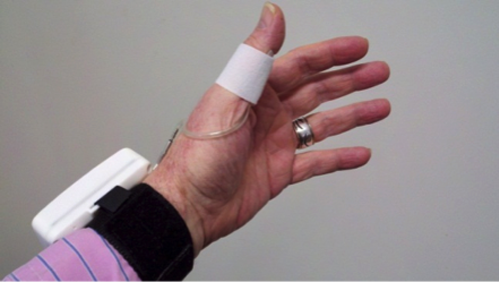CareTaker Vital Signs Monitor
November 10, 2014
CareTaker Vital Signs Monitor |
How does the device work?CareTaker is a small, vital signs monitor that extracts the arterial pressure waveform from a finger. Using proprietary algorithms, CareTaker tracks beat-by-beat blood pressure, ECG accurate heart rate, and respiration rate. A redesign includes SpO2 and an external temperature patch. CareTaker can be worn for prolonged sleep studies or for continuous patient monitoring and was validated to detect blood volume changes. CareTaker has been validated to detect arterial stiffness during long-term surgeries. Other hemodynamic parameters are being added. For hospital use, patients are continuously monitored using internal networks. After release, patients may take CareTaker home so that the vital signs are checked remotely by a caregiver. Data in the cloud is available for caregivers and shows up as historical or real-time data. What problem in healthcare does it solve?Electrodes are messy and uncomfortable. For the older population, really needing this information, skin is delicate and is often damaged by the electrode's adhesive. CareTaker does not cause dermatitis from extended use. Re-admission rates of heart failure patients could be slashed using CareTaker. CareTaker’s price, near $500, makes it affordable for hospitals and patients. The cellular system takes all the discovery, pairing, and connections out of the patient’s phone making CareTaker simple but effective. To get vitals at home, now requires purchasing a number of devices all having different radios and ways of communication; CareTaker does away with this unnecessary complexity. Why should the device be commercialized?Medicine is moving into the home and cost will keep many devices out of the home. The 2G cellular service used in CareTaker reaches 98% of the US population. There are no external hubs to carry around and no connection problems. There is one button that, when pushed, allows the sending vitals to a cloud server. What inspired you to design this device?Main inspiration: combat casualty care monitor for the Navy. Another inspiration comes from the fact that hospitals are consolidating making them less accessible. Doctors are becoming rarer as specialties claim more of them over GPs. CareTaker can replace most radial artery catheters with a noninvasive, re-usable device that eliminates blood born infections and/or blood clots, not to mention pain or discomfort. Accurate heart rate allows CareTaker to determine atrial fibrillation and other arrhythmias. CareTaker works using principles have never used in a medical device. This has resulted, for instance, in the detection and location of aortic aneurysms and other heart diseases. Hundreds of hours of validations have shown that we don’t know everything about the limits of CareTaker.
|
You May Also Like





